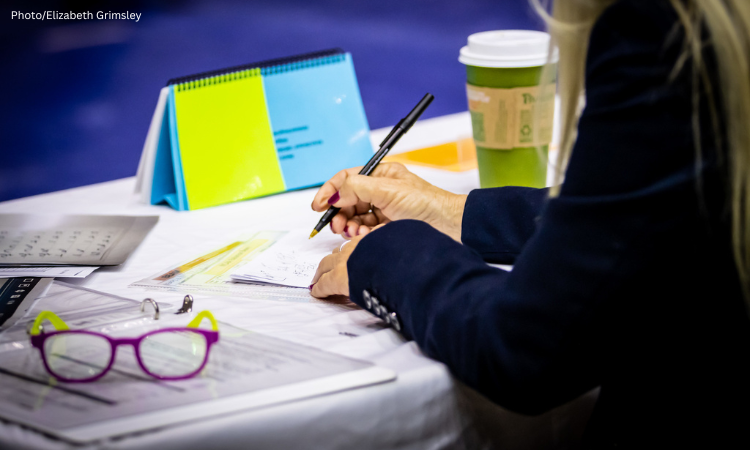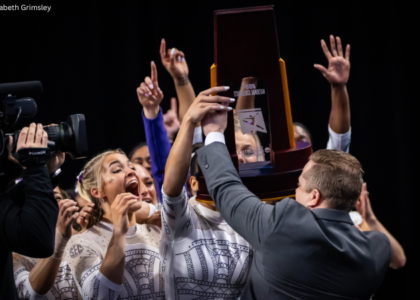Olympians and elite gymnasts are now competing in NCAA more than ever before now that they longer have to choose between professional endorsements and college athletics. For the first time ever, the reigning Olympic all-around champion is competing in NCAA gymnastics, as well as three of her gold medal winning teammates. Overall, this is a fantastic development for NCAA gymnastics, leading to record-breaking crowds where spectators will have the opportunity to see some of the best gymnastics in the world, live and in person, for a much more affordable price (and more often!) than an elite competition.
Judges aren’t immune from feeling star-stuck as well. After all, we probably watch more gymnastics than most, but it’s rare for an NCAA judge to also judge international elite gymnasts. NCAA judges have a front row seat to some of the most famous and recognizable female college athletes in the U.S., but does this make us blind to some of their deductions?
We can all agree that these athletes don’t need any favors from the judging panel to score well, so why does it seem like judges sometimes turn a blind eye? In this article, I’m going to focus on the 2020 Olympic athletes that are currently competing in college, and some of the errors they make that are consistently overlooked. To be fair, there are plenty of other elites and well-known athletes that also get away with some significant execution errors, but for this article, I’ve limited it to just the 2020 Olympic team.
Sunisa Lee
Vault: round-off half-on, front tuck half
Lee introduced a new vault this year that has many speculating that she is also training a Cheng for the 2024 Olympics. For this vault, the body should not begin to tuck until after she leaves the table. An early tuck is an up-to-three-tenth deduction. In the screen shot, she is completely tucked while still in support on the table, which should be the maximum deduction of three tenths. She also consistently has a shoulder angle on her block. With this and some obvious landing deductions, she has yet to score lower than a 9.850. Here are some examples from her vaults this season:
Sunisa Lee
Floor: double layout
Lee’s beautiful dance, flexibility, and artistry are on full display in her floor routine, but have you ever noticed the landing on her double layout? It’s up to two tenths for failure to maintain her body position, so this example should be a one-and-a-half- to two-tenth deduction, as she has about a 90-degree pike. Additionally, landing with the chest forward is also an up-to-two-tenth deduction. Realistically, this should be one- to two-tenth deduction since the NCAA judges tend to be more forgiving. In her season low against Florida, she piked down and under rotated her double layout, did not fully turn her leap pass, and took an extra step out of her second tumbling pass. Here are some other examples:
Jordan Chiles
Floor: double Layout
I couldn’t point out Lee’s double layout errors without also bringing up Chiles’ as well. This routine went 9.950, with almost the same body position error as Lee.
At UCLA vs. Oregon State, Chiles went 9.975 with a stuck double layout, but she still piked down and her chest was low on her landing. Two weeks later, Selena Harris performed a similarly stuck routine with body posture landing errors and received a 9.875. Chiles received a 10.000 on floor at that same meet, and while I can’t tell definitively if she piked down or not, based on these screenshots, I would guess yes.
Grace McCallum
Beam: mount and wolf turns
The beginning of McCallum’s beam routine features a forward roll mount, followed by a triple wolf turn and a double wolf turn. In her mount, she routinely pauses in the middle of her roll, sometimes even lifting and adjusting her hips to correct the direction of the roll. I would consider this a balance error, as the roll should be continuous. I considered that perhaps the judges were considering it as choreography rather than a roll. However, Grace needs the forward roll to avoid a compositional deduction since it is the only forward or sideward element in her beam routine. As for her wolf turns, her arms are usually moving up and down throughout the turn, and the speed of turn also seems slow. Together, these make the turn feel unsure, and I would consider it a balance error and/or a posture error on her turn. Here are some examples:
Jade Carey
Bars and Beam
Carey has a reputation for being one of the most powerful gymnasts in the world but does not always have perfect form or the best artistry. Bars and beam are not her strongest events, but with the NCAA level of difficulty being lower than in elite, her form has definitely improved. Unlike the previous analysis, there aren’t any technique or execution errors that she makes every time. That said, she does still consistently struggle with her leg form on her between-bar releases, and she has some flexed feet and short handstands but still scores generally well. On beam, I’ve noticed a couple of questionable connections in her dance series that should at least receive a rhythm deduction. In her routine against Washington, she wobbles within the connection and still scores a 9.950.
Jade Carey
Vault : Yurchenko double full
The screenshots above are from her 9.975 vault at the Oregon State quad meet, where she also hops her feet together at the end of her vault. Carey also famously scored a perfect 10.0 vault with a hop at the Wasatch Classic, and another 10.0 with some (minor) leg form errors. Her second 10.0 was much closer to perfect, but especially with the camera angle, it is clear that the vault was not perfect.
These athletes are undeniably some of the best gymnasts in the world, as well as consistently score well in the NCAA. However, no one is perfect, and even Olympians make mistakes every now and again, especially when they are competing every weekend during the NCAA season.
I feel like a broken record at this point, but this is just another example of why it’s important to score each athlete based on what they do on that day, not based on what they are capable of doing, what they’ve done in the past, or how excited the crowd may react to the performance.
READ THIS NEXT: Judge’s Inquiry: Breaking Down One Near-Perfect Routine on Each Event From Week 7
Article by Rhiannon Franck
Rhiannon Franck is a former national-rated NAWGJ women’s gymnastics judge with over 15 years of USAG judging experience and nine seasons judging NCAA gymnastics. Outside of gymnastics, Franck works at a university as a nursing professor and loves to travel.
Like what you see? Consider donating to support our efforts throughout the year!





I appreciate this article so much. I see this a lot, both with elites in the NCAA, and certain teams. I believe the judges are giving consideration to high difficulty as well, but until the rules change they shouldn’t be. No routine can start above a 10. So, more difficulty shouldn’t help your score, and it routinely does. It makes me not really appreciate the elites coming to the college level, which frustrates me because I love them! I just want to see the judges take the same deductions regardless of the difficulty.
Jade Carey has not improved her form or her artistry. You need to stop fabricating a lie. Her fans can state this as a fact but the fact is, she hasn’t improved.
It is not fair to the rest of the College Gymnastics community to watch Suni, Jade, Jordan, Trinity, Leanne, Aleah, and Kayla Dicello, as well as the same College programs handing out 10s or 9.950s to clearly flawed gymnastics. It’s always the same gymnasts.
The only thing College sports care about is making money, which is why this will never be addressed.
I understand the controversy over college athletes earning money as collegiate athletes. There is a legitimate concern that soon only a handful of large universities will be able to field championship teams as smaller schools may struggle to attract talent. I think that there are two opportunities for the advancement of sports. First, it may encourage a population of older athletes and open up the doors of expensive sports such as gymnastics to a larger, more socially diverse population. Elite gymnastics could use a larger team energy as well as a greater emphasis on performance. More so, elite gymnastics should move away from an emphasis on pre-adolescent body shapes and lines . We see in track and field and other sports, many women performing better in their college and post collegiate careers as their bodies peak. The economics of gymnastics prevents this from manifesting. I think that it’s time to grow.